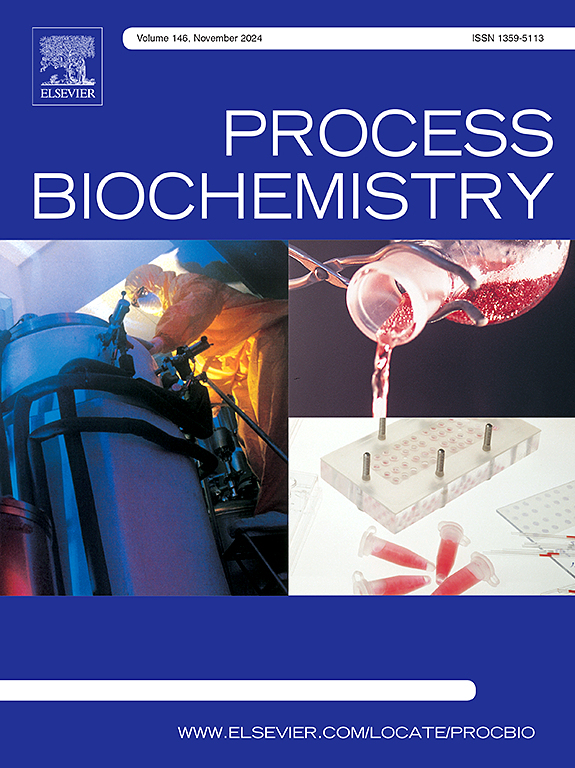Preparation of a novel laccase-modified Fe3O4/TiO2 catalyst for simultaneous delignification and saccharification of Spartina alterniflora Loisel
IF 3.7
3区 生物学
Q2 BIOCHEMISTRY & MOLECULAR BIOLOGY
引用次数: 0
Abstract
The development of a cost-effective and environment-friendly conversion method to overcome the recalcitrance of biomass is a challenging task for enhancing the value-added potential of lignocellulosic compounds. In this study, a photo-enzyme composite catalyst by immobilizing laccase on Fe3O4/TiO2 (denoted as LC-Fe3O4/TiO2) was applied to the pretreatment and enzymatic saccharification of Spartina alterniflora Loisel (SAL) under the action of alternating light/dark cycles. The effect of the pretreatment temperature, pretreatment time, LC-Fe3O4/TiO2 concentration, mass concentration of straw particles, and hydrolysis time on delignification efficiency and reducing sugar yield was investigated by a central composite design (CCD). Under the selected conditions (48 ℃, pretreatment time of 70 min, LC-Fe3O4/TiO2 concentration of 4.9 mg/mL, mass concentration of straw particles of 22 % (w/v), hydrolysis time of 55 h), 92.53 % delignification and 129.85 mg/g reducing sugar yield were achieved. The enzymatic hydrolysis efficiency was higher compared to conventional methods. Moreover, the LC-Fe3O4/TiO2 showed good recyclability and reusability. Developed LC-Fe3O4/TiO2 particles have a high potential for use in biomass utilization.
制备新型漆酶改性的 Fe3O4/TiO2 催化剂,用于同时进行交替叶斯巴达Loisel的脱木质和糖化处理
要提高木质纤维素化合物的增值潜力,开发一种具有成本效益且环境友好的转化方法来克服生物质的难降解性是一项具有挑战性的任务。本研究将固定化漆酶于 Fe3O4/TiO2 上的光酶复合催化剂(简称 LC-Fe3O4/TiO2)应用于光/暗交替循环作用下 Spartina alterniflora Loisel(SAL)的预处理和酶法糖化。通过中心复合设计(CCD)研究了预处理温度、预处理时间、LC-Fe3O4/TiO2浓度、秸秆颗粒质量浓度和水解时间对脱木质素效率和还原糖产量的影响。在所选条件下(48 ℃、预处理时间 70 分钟、LC-Fe3O4/TiO2 浓度 4.9 mg/mL、秸秆颗粒质量浓度 22 % (w/v)、水解时间 55 h),木质素脱除率达到 92.53%,还原糖产量达到 129.85 mg/g。与传统方法相比,酶水解效率更高。此外,LC-Fe3O4/TiO2 还具有良好的可回收性和可再利用性。开发的 LC-Fe3O4/TiO2 颗粒在生物质利用方面具有很大的应用潜力。
本文章由计算机程序翻译,如有差异,请以英文原文为准。
求助全文
约1分钟内获得全文
求助全文
来源期刊

Process Biochemistry
生物-工程:化工
CiteScore
8.30
自引率
4.50%
发文量
374
审稿时长
53 days
期刊介绍:
Process Biochemistry is an application-orientated research journal devoted to reporting advances with originality and novelty, in the science and technology of the processes involving bioactive molecules and living organisms. These processes concern the production of useful metabolites or materials, or the removal of toxic compounds using tools and methods of current biology and engineering. Its main areas of interest include novel bioprocesses and enabling technologies (such as nanobiotechnology, tissue engineering, directed evolution, metabolic engineering, systems biology, and synthetic biology) applicable in food (nutraceutical), healthcare (medical, pharmaceutical, cosmetic), energy (biofuels), environmental, and biorefinery industries and their underlying biological and engineering principles.
 求助内容:
求助内容: 应助结果提醒方式:
应助结果提醒方式:


